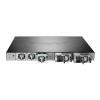-
€


El D-Link DXS-3400-24SC es un switch gestionable con 20 ranuras SFP + (10 Gb / s) y 4 puertos combinados 10G (puede elegir entre 10G Ethernet o SFP +). El dispositivo se distingue por su alta eficiencia: el ancho de banda es de 480 Gb / sy la velocidad de reenvío de paquetes es de 357,12 Mp / s. Perfecto como switch principal en muchas redes, fue diseñado para su uso en Data Center. Tiene una serie de funciones DCB (Data Center Bridging) que garantizan el ancho de banda completo de Ethernet: 802.1Qbb, 802.1Qaz y 802.1Qau. Está equipado con un adaptador de AC incorporado, el consumo máximo de energía es de 118,6 W.
La máquina admite funciones de gestión avanzadas de Layer 2 i Layer 3. En la capa 2, admite, entre otros, Flow Control, protocolos de Spanning Tree, 802.1AX Link Aggregation, VLAN / flow / port mirroring o L2 protocol tunneling. También es compatible con L2 Multicast: MLD Snooping, IGMP Snooping y PIM Snooping. En la capa 3, admite el routing, incluido el routing estático, el hardware routing, BFD o RIP. Permite la configuración avanzada de VLAN, admite 802.1Q, 802.1v, Q-in-Q, Voice VLAN, Auto Surveilliance VLAN, VLAN trunking y muchas otras funciones. El switch también está diseñado para apilarse, en una pila física puede conectar hasta 4 dispositivos con un ancho de banda de 80 Gb / s, en una topología de ring o chain. La administración se realiza a través de la interfaz de usuario web en un navegador, Telnet o D-Link.
¡El juego incluye 1 módulo de potencia!
Características principales:
- 20 ranuras SFP+ (10 Gb/s);
- 4 puertos 10G Combo (10G Ethernet lub SFP+);
- rendimiento de conmutación: 480 Gb / s;
- velocidad de reenvío de paquetes: 357,12 Mp / s;
- apilar hasta 4 dispositivos en una pila física;
- Gestión Layer 3.
Especificación:
| DXS-3400-24SC | |
| Propiedades generales | |
|---|---|
| Interfaces |
20 ranuras SFP+ 10 Gb/s
4 puertos 10G Combo - 10G Ethernet o SFP+ 10 Gb/s |
| Puerto de consola | RJ-45 i miniUSB |
| Puerto de administración | 10/100/1000BASE-T RJ-45 Ethernet |
| Puetos USB | 1 |
| Rendimiento | |
| Capacidad de conmutación | 480 Gb/s |
| Velocidad de reenvío de paquetes | 357,12 Mp/s |
| Búfer de paquetes | 4 MB |
| Tabla de direcciones MAC | 48K |
| Propiedades físicas | |
| Entrada de alimentación | 100 - 240 V AC |
| Consumo máximo de energía | 118,6 W |
| Consumo de energía en standby |
64,8 W |
| Liberación de calor | 388.39 BTU/hr |
| Dimensiones | 441 x 44 x 380 mm (17.32 x 1.73 x 14.96 inches) |
| Peso | 6,5 kg |
| Temperatura de funcionamiento permitida | De -5 a 50 gr. C |
| Temperatura de almacenamiento permitida | De -40 a 70 gr. C |
| Humedad del aire permitida | 0%-95% RH sin condensación |
|
Humedad del aire permitida durante el almacenamiento |
0%-95% RH sin condensación |
| Certificados | |
| Seguridad | cUL, CB, CE, CCC, BSMI |
| EMI / EMC | CE, FCC, C-Tick, VCCI, BSMI, CCC |
| Propiedades del software | |
|
Stackability
|
Stacking físico
Stacking virtual
|
| Funciones Layer 2 | MAC Address Table
Port mirroring
L2 protocol tunneling Loopback Detection (LBD) iSCSI awareness Multi-Chassis Link Aggregation (MLAG) |
| Funciones Layer 2 Multicast | MLD Snooping
|
| Funciones Layer 3 | ARP
IPv6 Neighbor Discovery (ND) UDP helper IPv6 tunneling
VRRP v2/v3 |
| Layer 3 routing | Static routing
Policy-based Route (PBR) Null route Bidirectional Forwarding Detection (BFD)
RIP
Route Redistribution
|
| VLAN | 802.1Q 802.1v Double VLAN (Q-in-Q)
Port-based VLAN MAC-based VLAN Subnet-based VLAN Private VLAN VLAN group
Voice VLAN Auto Surveilliance VLAN VLAN trunking GVRP
|
| AAA | 802.1X authentication
Web-based Access Control (WAC)
Microsoft NAP
Authentication Database Failover Guest VLAN |
| Quality of Service (QoS) | 802.1p Quality of Service 8 queues per port QoS based on
|
| Data Center Bridging (DSB) | 802.1Qbb Priority-based Flow Control (PFC) 802.1Qaz Enhanced Transmission Selection (ETS) 802.1Qau Congestion Notification (CN) |
| Control de acceso (ACL) | ACL based on:
|
| Seguridad | Port Security
D-Link Safeguard Engine DHCP server screening IP-MAC-Port Binding Dynamic ARP Inspection IP Source Guard DHCP Snooping IPv6 Snooping DHCPv6 Guard IPv6 Route Advertisement (RA) Guard IPv6 ND Inspection ARP Spoofing Prevention
L3 Control Packet Filtering Traffic Segmentation SSL
DoS attack prevention |
| OAM | Cable diagnostics 802.3ah Ethernet link OAM D-Link Unidirectional Link Detection (DULD) Dying Gasp 802.1ag Connectivity Fault Management (CFM) Y.1731 OAM Optical Transceiver Digital Diagnostic Monitoring (DDM) |
| Gestión | Web-based GUI CLI Telnet server Telnet client TFTP client FTP client Secure FTP (SFTP) server Traffic monitoring SNMP
System log DHCP client DHCP server DHCP Relay options 60, 61, 82 Multiple images Multiple configurations Flash file system DNS client CPU monitoring MTU setting ICMP tools
DNS Relay SMTP DHCP Auto Configuration NTP RCP (Remote Copy Protocol) RMON v1/v2 Trusted host Password encryption Debug command sFlow Switch Resource Management (SRM) Microsoft Network Load Balancing (NLB) |
| Estándares | |
| MIB i RFC | MIB Structure: RFC1065, RFC1066, RFC1155, RFC1156, RFC2578 Concise MIB Definitions: RFC1212 MIBII: RFC1213 MIB Traps Convention: RFC1215 Bridge MIB: RFC1493, RFC4188 SNMP MIB: RFC1157, RFC2571, RFC2572, RFC2573, RFC2574, RFC2575, RFC2576 SNMPv2 MIB: RFC1442, RFC1901, RFC1902, RFC1903, RFC1904, RFC1905, RFC1906, RFC1907, RFC1908, RFC2578, RFC3418, RFC3636 RMON MIB: RFC271, RFC1757, RFC2819 RMONv2 MIB: RFC2021 Ether-like MIB: RFC1398, RFC1643, RFC1650, RFC2358, RFC2665, RFC3635 802.3 MAU MIB: RFC2668 802.1p MIB: RFC2674, RFC4363 Interface Group MIB: RFC2863 RADIUS Authentication Client MIB: RFC2618 MIB for TCP: RFC4022 MIB for UDP: RFC4113 MIB for Diffserv.: RFC3298 RADIUS Accounting Client MIB: RFC2620 Ping & TRACEROUTE MIB: RFC2925 Running configuration writes and backup (D-Link MIB) TFTP uploads and downloads (D-Link MIB) Trap MIB (D-Link MIB) IPv6 MIB: RFC2465 ICMPv6 MIB: RFC2466 Entity MIB: RFC2737 VRRP MIB: RFC2787 RIPv2 MIB: RFC1724 OSPF MIB: RFC1850 IPv4 Multicast Routing MIB: RFC5132, RFC2932 PIM MIB for IPv4: RFC2934 IP Forwarding Table MIB: RFC4292 IPv6 SNMP Mgmt Interface MIB: RFC4293 DDM MIB (D-Link MIB) Private MIB (D-Link MIB) DIFFSERV MIB (D-Link MIB) MIB for D-Link Zone Defense (D-Link MIB) IP: RFC791 UDP: RFC768 TCP: RFC793 ICMPv4: RFC792 ICMPv6: RFC2463, RFC4443 Extended ICMP to Support Multi-Part Messages: RFC4884 ARP: RFC826 CIDR: RFC1338, RFC1519 Definition of the DS Field in the IPv4 and IPv6 Headers: RFC2474, RFC3168, RFC3260 Extensible Authentication Protocol (EAP): RFC1321, RFC2284, RFC2865, RFC2716, RFC1759, RFC3580, RFC3748 SNMP Framework: RFC2571 SNMP Message Processing and Dispatching: RFC2572 SNMP Applications: RFC2573 User-based Security Model for SNMPv3: RFC2574 Expedited Forwarding PHB (Per-Hop Behavior): RFC3246 Supplemental Information for the New Definition of the EF PHB (Expedited Forwarding Per-Hop Behavior): RFC3247 DNS extension support for IPv6: RFC1886 Path MTU Discovery for IPv6: RFC1981 IPv6: RFC2460 Neighbor Discovery for IPv6: RFC2461, RFC4861 IPv6 Stateless Address Auto-configuration: RFC2462, RFC4862 IPv6 over Ethernet and definition: RFC2464 Dual Stack Hosts using the “Bump-In-the-Stack” Technology: RFC2767 IPv6 Addressing Architecture: RFC3513, RFC4291 IPv4/IPv6 dual stack function: RFC2893, RFC4213 Default Address Selection for Internet Protocol version 6: RFC3484 IP-IP tunnel: IP Encapsulation within IP: RFC2003 IP-IP tunnel:Allow MTU = 1500 or 1520: RFC1191 L2 distributed tunnel - CAPWAP Encapsulation: RFC5415 |






 Polski
Polski English
English Italiano
Italiano Español
Español Čeština
Čeština Српски
Српски Deutsch
Deutsch Ελληνικά
Ελληνικά Slovenský
Slovenský




